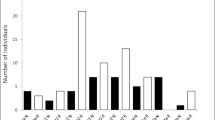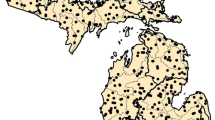Abstract
The introduction of some crustacean species has produced alterations of freshwater environments and declines of native species worldwide. The red swamp crayfish, Procambarus clarkii Girard, was introduced in the Southwest Iberian Peninsula in the 1970’s, producing severe impacts on rice agriculture and on native biota such as macrophytes, gastropods, native crayfish and amphibians. We studied the distribution of P. clarkii in two areas of SW Iberian Peninsula: the Sado River basin (SW Portugal), an area colonized by this species around 1990, and the Parque Natural del Entorno de Doñana (SW Spain), colonized soon after its introduction in the Iberian Peninsula, in the 1970’s. Our main goal was to determine which factors limit crayfish distribution, which could help to identify the most effective management practices to contain its spread. Procambarus clarkii was found in most types of water bodies, including small and shallow ones. Distance to a crayfish source was the single predictor variable explaining crayfish occurrence in most types of habitats and in both areas. The only exception was for the Sado permanent stream points, where crayfish presence was negatively affected by an interaction between elevation and flow velocity. Other habitat characteristics have apparently little or no importance for its successful colonization. Moreover, this study indicated that overland dispersal is apparently a frequent phenomenon in this species. Our findings can be used to determine which habitats are most likely to be colonized by the crayfish and to develop practical measures which may limit its spread and minimize its impacts.




Similar content being viewed by others
References
Anastácio, P. M. & J. C. Marques, 1995. Population biology and production of the red swamp crayfish Procambarus clarkii (Girard) in the lower Mondego valley, Portugal. Journal of Crustacean Biology 15: 156–168.
Anastácio, P. M., A. F. Frias & J. C. Marques, 2000. Impact of crayfish densities on wet seeded rice and the inefficiency of a non-ionic surfactant as an ecotechnological solution. Ecological Engineering 15: 17–25.
Baillie, J. E. M., C. Hilton-Taylor & S. N. Stuart, 2004. 2004 UICN red list of threatened species: a global species assessment. IUCN, Gland, Switzerland and Cambridge.
Barbaresi, S. & F. Gherardi, 2000. The invasion of the alien crayfish Procambarus clarkii in Europe, with particular reference to Italy. Biological Invasions 2: 259–264.
Barbaresi, S., G. Santini, E. Tricarico & F. Gherardi, 2004. Ranging behaviour of the invasive crayfish, Procambarus clarkii (Girard). Journal of Natural History 38: 2821–2832.
Bravo, M. A., C. M. Duarte & C. Montes, 1994. Environmental factors controlling the life history of Procambarus clarkii (Decapoda, Cambaridae) in a temporary marsh of the Doñana National Park (SW Spain). Internationale Vereinigung fuer Theoretische und Angewandte Limnologie, Verhandlungen 25: 2450–2453.
Correia, A. M., 1995. Population dynamics of Procambarus clarkii (Crustacea: Decapoda) in Portugal. Freshwater Crayfish 8: 276–290.
Correia, A. M., 2003. Food choice by the introduced crayfish Procambarus clarkii. Annales Zoologici Fennici 40: 517–528.
Correia, A. M. & O. Ferreira, 1995. Burrowing behaviour of the introduced red swamp crayfish Procambarus clarkii (Decapoda: Cambaridae) in Portugal. Journal of Crustacean Biology 15: 248–257.
Cronin, G., D. M. Lodge, M. E. Hay, M. Miller, A. M. Hill, T. Horvath, R. C. Bolser, N. Lindquist & M. Wahl, 2002. Crayfish feeding preferences for freshwater macrophytes: the influence of plant structure and chemistry. Journal of Crustacean Biology 22: 708–718.
Cruz, M. J., P. Andrade, S. Pascoal & R. Rebelo, 2004. Colonização anual de charcos temporários pelo Lagostim-vermelho-americano, Procambarus clarkii. Revista de Biologia 22: 79–90.
Cruz, M. J. & R. Rebelo, 2005. Vulnerability of Southwest Iberian amphibians to an introduced crayfish, Procambarus clarkii. Amphibia-Reptilia 26: 293–304.
Cruz, M. J., R. Rebelo & E. G. Crespo, 2006. Effects of an introduced crayfish, Procambarus clarkii, on the distribution of South-western Iberian amphibians in their breeding habitats. Ecography 29:329–338.
García-Berthou, E., C. Alcaraz, Q. Pou-Rovira, L. Zamora, G. Coenders & C. Feo, 2005. Introduction pathways and establishment rates of invasive aquatic species in Europe. Canadian Journal of Fisheries and Aquatic Sciences 62: 453–463.
Geiger, W., P. Alcorlo, A. Baltanás & C. Montes, 2005. Impact of an introduced crustacean on the trofic webs of Mediterranean wetlands. Biological Invasions 7: 49–73.
Gherardi, F. & S. Barbaresi, 2000. Invasive crayfish: activity patterns of Procambarus clarkii in the rice fields of Lower Guadalquivir (Spain). Archiv fur Hydrobiologie 150: 153–168.
Gherardi, F., S. Barbaresi & G. Salvi, 2000. Spatial and temporal patterns in the movement of Procambarus clarkii, an invasive crayfish. Aquatic Sciences 62: 179–193.
Gil-Sánchez, J. M. & J. Alba-Tercedor, 2002. Ecology of the native and introduced crayfishes Austropotamobius pallipes and Procambarus clarkii in southern Spain and implications for conservation of the native species. Biological Conservation 105: 75–80.
Guan, R.-Z. & P. R. Wiles, 1997. Ecological impacts of introduced crayfish on benthic fishes in a British lowland river. Conservation Biology 11: 641–647.
Gutiérrez-Yurrita, P. J. & C. Montes, 1999. Bioenergetics and phenology of reproduction of the introduced red swamp crayfish, Procambarus clarkii, in Doñana national park, Spain, and implications for species management. Freshwater Biology 42: 561–574.
Gutiérrez-Yurrita, P. J., G. Sancho, M. A. Bravo, A. Baltanás & C. Montes, 1998. Diet of the red swamp crayfish Procambarus clarkii in natural ecosystems of the Doñana national park temporary fresh–water marsh (Spain). Journal of Crustacean Biology 18: 120–127.
Harper, D. M., A. C. Smart, S. Coley, S. Schmitz, A. -C. G. Beauregard, R. North, C. Adams, P. Obade & M. Kamau, 2002. Distribution and abundance of the Louisiana red swamp crayfish Procambarus clarkii Girard at Lake Naivasha, Kenya, between 1987 and 1999. Hydrobiologia 488: 143–151.
Habsburgo-Lorena, A. S., 1983. Socioeconomic aspects of the crawfish industry in Spain. Freshwater Crayfish 5: 552–554.
Hastings , A., 1996. Models of spatial spread: a synthesis. Biological Conservation 78: 143–148.
Hobbs, H. H., J. P. Jass & J. V. Huner, 1989. A review of global crayfish introductions with particular emphasis on two North American species. Crustaceana 56: 299–316.
Hobbs, R. J. & H. A. Mooney, 1998. Broadening the extinction debate: population deletions and additions in California and Western Australia. Conservation Biology 12: 271–283.
Hosmer, D. W. & S. Lemeshow, 2000. Applied logistic regression. Wiley-Interscience Publication. John Wiley and Sons, Inc., New York.
Jiménez, A., E. Cano & M. E. Ocete, 2003. Mortality and survival of Procambarus clarkii Girard, 1852 upon exposure to different insecticide products. Bulletin of Environmental Contamination and Toxicology 70: 131–137.
Kerby, J. L., S. P. D. Riley, L. B. Kats & P. Wilson, 2005. Barriers and flow as limiting factors in the spread of an invasive crayfish (Procambarus clarkii) in southern California streams. Biological Conservation 126: 402–409.
Lodge, D. M., R. A. Stein, K. M. Brown, A. P. Covich, C. Brönmark, J. E. Garvey & S. P. Klosiewski, 1998. Predicting impact of freshwater exotic species on native biodiversity: challenges in spatial scaling. Australian Journal of Ecology 23: 53–67.
Lodge, D. M., C. A. Taylor, D. M. Holdich & J. Skurdal, 2000. Nonindigenous crayfishes threaten north American freshwater biodiversity: lessons from Europe. Fisheries 25: 7–20.
Nyström, P., O. Svensson, B. Lardner, C. Brönmark & W. Granéli, 2001. The influence of multiple predators on a littoral pond community. Ecology 82: 1023–1039.
Parker, I. M., D. Simberloff, W. M. Lonsdale, K. Goodell, M. Wonham, P.M. Kareiva, M. H. Williamson, B. Von Holle, P. B. Moyle, J. E. Byers & L. Goldwasser, 1999. Impact: toward a framework for understanding the ecological effects of invaders. Biological Invasions 1: 3–19.
Ramos, M. A. & T. M. Pereira, 1981. Um novo Astacidae para a fauna portuguesa: Procambarus clarkii (Girard, 1852). Boletim Instituto Nacional Investigação e Pescas 6: 37–47.
Rodríguez, C. F., E. Bécares & M. Fernández-Aláez, 2003. Shift from clear to turbid phase in Lake Chozas (NW Spain) due to introduction of American red swamp crayfish (Procambarus clarkii). Hydrobiologia 506–509: 421–426.
Rodríguez, C. F., E. Bécares, M. Fernández-Aláez & C. Fernández-Aláez, 2005. Loss of diversity and degradation of wetlands as a result of introducing exotic crayfish. Biological Invasions 7: 75–85.
Ross, R. M., W. A. Lellis, R. M. Bennett & C. S. Johnson, 2001. Landscape determinants of nonindigenous fish invasions. Biological Invasions 3: 347–361.
Sala, O. E., F. S. Chapin III, J. J. Armesto, E. Berlow, J. Bloomfield, R. Dirzo, E. Huber-Sanwald, L. F. Huenneke, R. B. Jackson, A. Kinzig, R. Leemans, D. M. Lodge, H. A. Mooney, M. Oesterheld, N. LeRoy Poff, M. T. Sykes, B. H. Walker, M. Walker & D. H. Wall, 2000. Global Biodiversity Scenarios for the Year 2100. Science 287: 1770–1774.
Sakai, A. K., F. W. Allendorf, J. S. Holt, D. M. Lodge, J. Molofsky, K. A. With, S. Baughman, R. J. Cabin, J. E. Cohen, N. C. Ellstrand, D. E. Mccauley, P. O’Neil, I. E. Parker, J. N. Thompson & S. G. Weller, 2001. The population biology of invasive species. Annual Reviews in Ecology and Systematics 32: 305–332.
Smart, A. C., D. M. Harper, F. Malaisse, S. Schmitz, S. Coley & A. -C. G. Beauregard, 2002. Feeding of the exotic Louisiana red swamp crayfish, Procambarus clarkii (Crustacea, Decapoda), in an African tropical lake: Lake Naivasha, Kenya. Hydrobiologia 488: 129–142.
Shurin, J. B. & J. E. Havel, 2002. Hydrologic connections and overland dispersal in exotic freshwater crustacean. Biological Invasions 4: 431–439.
Westman, K., R. Savolainen & M. Julkunen, 2002. Replacement of the native crayfish Astacus astacus by the introduced species Pacifastacus leniusculus in a small, enclosed Finnish lake: a 30-year study. Ecography 25: 53–73.
Acknowledgements
We thank M. Tejedo for precious help in the visits to Doñana, A.Sumares, P. Andrade, S. Amaral and S. Pascoal for their help in the field work, and R. Braz for the map production. This research was supported by a FCT and FSE grant (SFRH/BD/6286/2001), by Project PNAT/1999/BIA/15039/C of FCT and ICN, and by the European Community-Access to Research Infrastructure Action of the Improving Human Potential Programme in Doñana Biological Station (Ecodoca).
Author information
Authors and Affiliations
Corresponding author
Additional information
Handling editor: K. Martens
Rights and permissions
About this article
Cite this article
Cruz, M.J., Rebelo, R. Colonization of freshwater habitats by an introduced crayfish, Procambarus clarkii, in Southwest Iberian Peninsula. Hydrobiologia 575, 191–201 (2007). https://doi.org/10.1007/s10750-006-0376-9
Received:
Revised:
Accepted:
Published:
Issue Date:
DOI: https://doi.org/10.1007/s10750-006-0376-9




